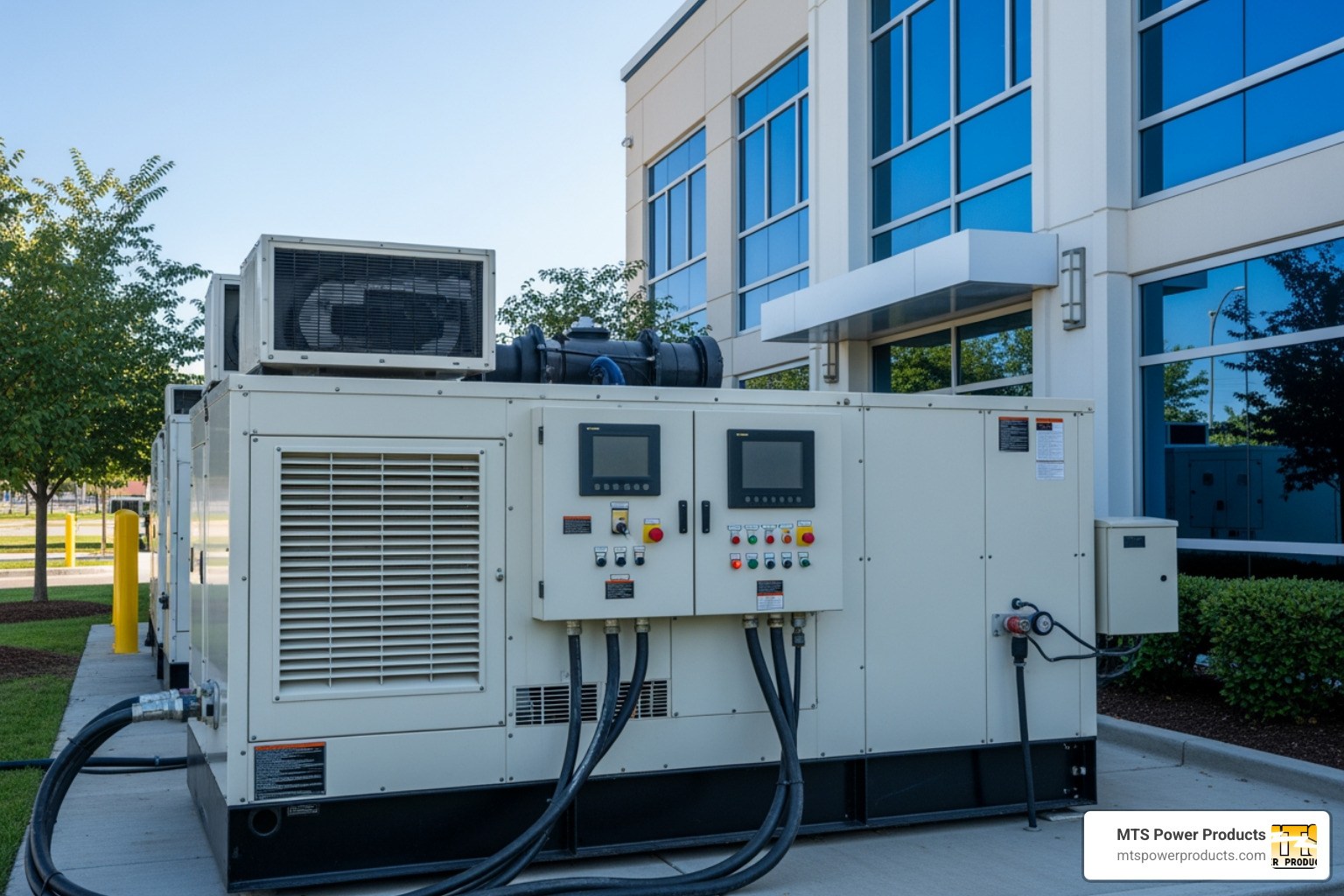
Buy Direct
from the Manufacturer
Sell our Products
Become a Distributor
Discounts
on volume purchases
Visit Us
at our Miami office
from the Manufacturer
Become a Distributor
on volume purchases
at our Miami office
An auto transfer switch for portable generator is a smart electrical device that automatically detects power outages and switches your home’s power supply from the utility grid to your portable generator – no manual intervention required.
Quick Answer: What You Need to Know
Picture this: It’s 2 AM during a hurricane, and your power goes out. Instead of stumbling around in the dark with extension cords, your generator automatically starts and your essential circuits come back online. That’s the power of an automatic transfer switch.
The old way meant running multiple extension cords from your generator to individual appliances – creating trip hazards, overloading circuits, and risking electrocution. The smart way uses an ATS to safely connect your portable generator directly to your home’s electrical system.
An automatic transfer switch acts as the “brain” of your backup power system. It constantly monitors your utility power and, when it detects an outage, signals your compatible portable generator to start and seamlessly transfers your home’s electrical load to generator power. When utility power returns, it switches back and shuts down the generator.
This technology bridges the gap between basic portable generators and expensive whole-house standby systems, giving you automatic backup power at a fraction of the cost.
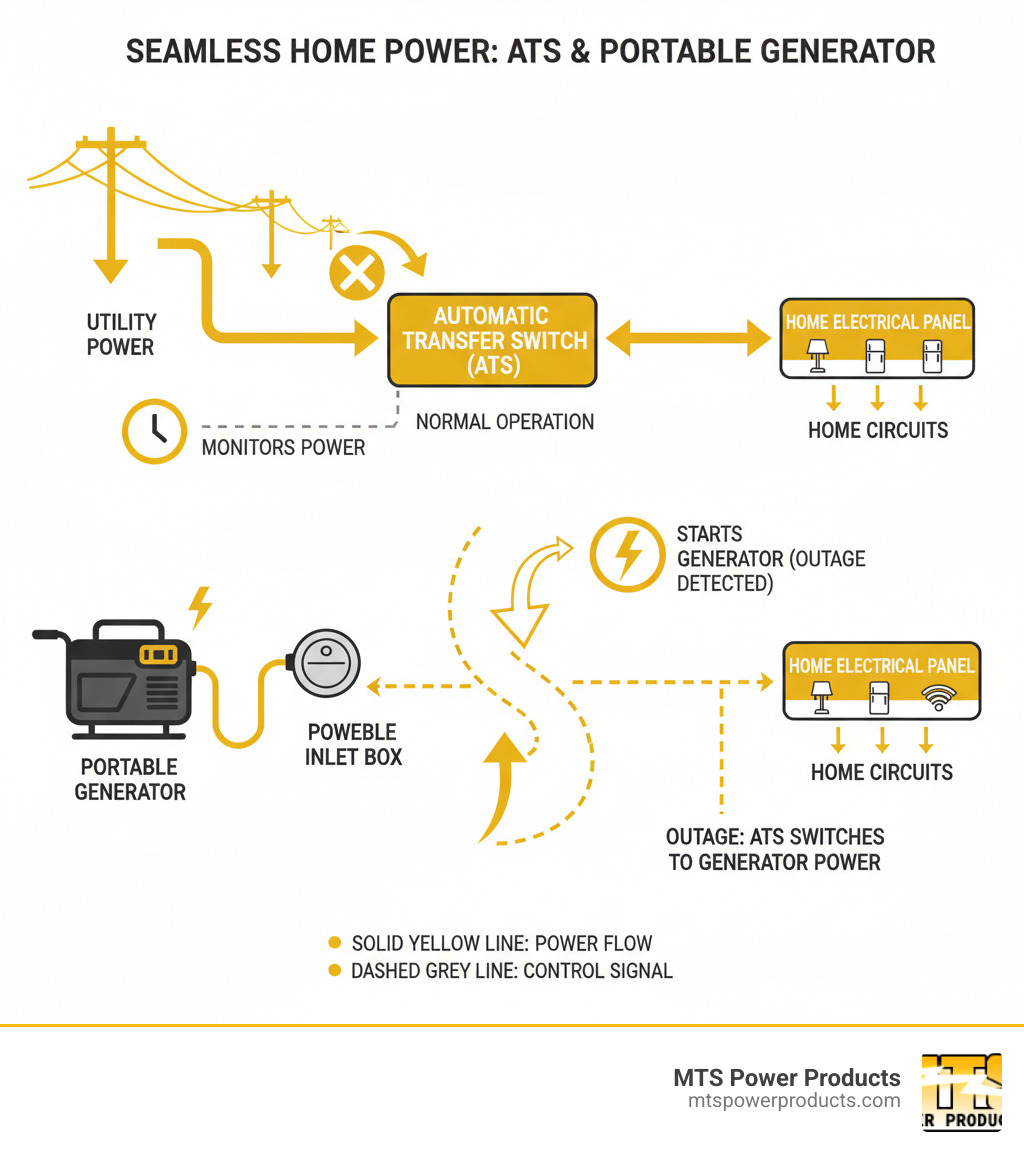
Explore more about auto transfer switch for portable generator:
Think of an auto transfer switch for portable generator as the brilliant conductor of your home’s power orchestra. While you’re going about your daily life, this smart device is constantly watching, listening, and ready to spring into action the moment your lights go out.
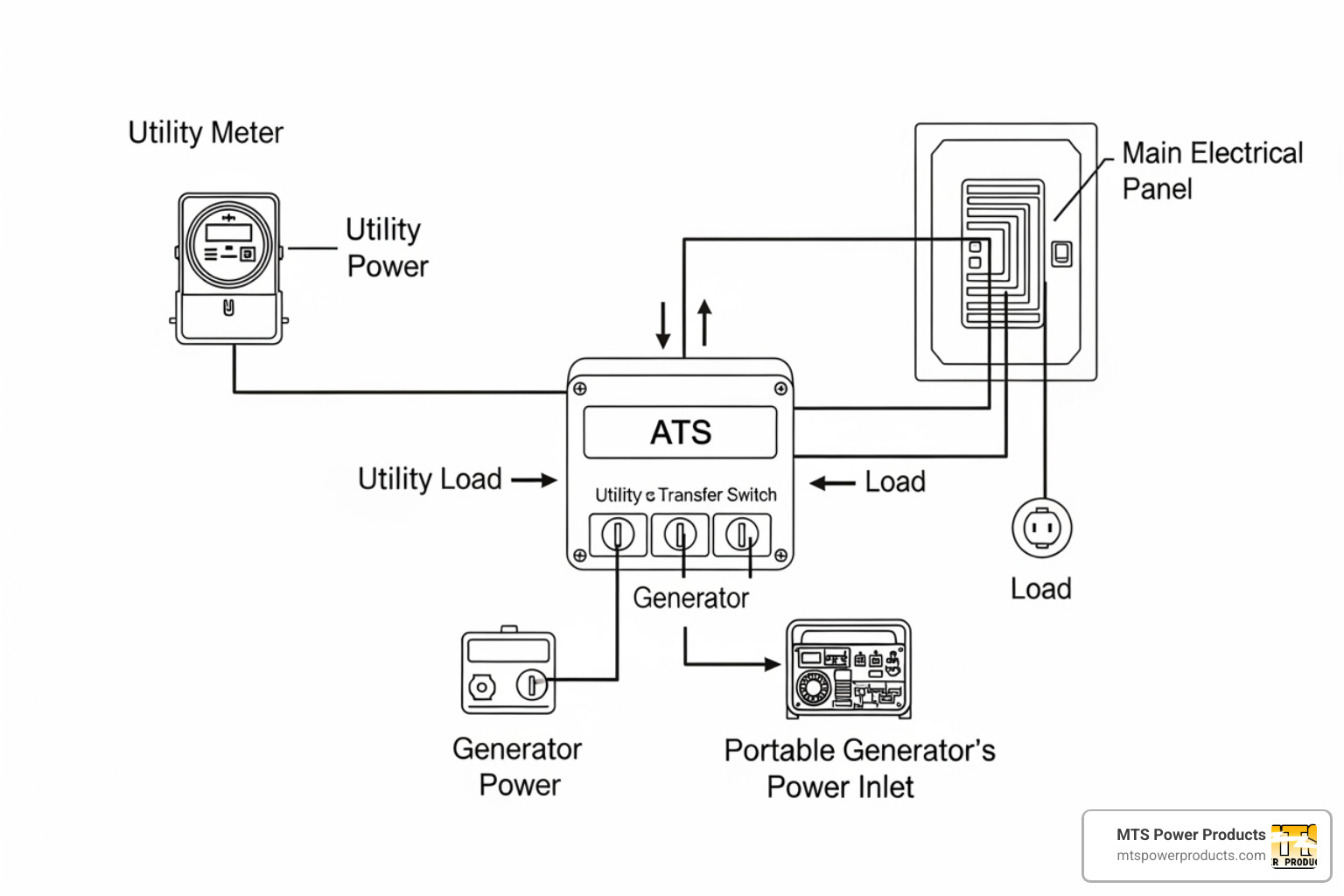
The magic begins with monitoring utility power. Your ATS never sleeps – it’s constantly checking the voltage and frequency coming from your utility company. It’s like having a vigilant security guard who never takes a coffee break, always making sure everything’s running smoothly.
When the inevitable happens and power goes out, your ATS detects this faster than you can say “where’s my flashlight?” The moment voltage drops below acceptable levels or disappears entirely, the switch knows something’s wrong. This isn’t just about total blackouts – it also catches those frustrating brownouts that can damage your appliances.
Here’s where things get exciting. The ATS immediately signals your generator to start through a special two-wire connection. No more stumbling outside in your pajamas during a storm! Your compatible portable generator receives this electronic wake-up call and roars to life automatically.
But safety comes first. The ATS uses what’s called a break-before-make mechanism – it completely disconnects your home from the utility grid before connecting to generator power. Think of it as changing lanes on the highway – you don’t occupy both lanes at once! This prevents dangerous backfeeding that could harm utility workers trying to restore power.
Once your generator is producing stable electricity, the switch transfers your home’s electrical load from dead utility lines to your running generator. Your refrigerator starts humming again, your heating system kicks back on, and life returns to normal.
The best part? When utility power returns, your ATS seamlessly switches everything back. It monitors the utility lines and, once it confirms power is stable, reverses the entire process. Your home reconnects to the grid, and your generator gets the signal to shut down after a brief cool-down period.
Remember the old days of dragging extension cords through your house like some kind of electrical octopus? Those days are over with an auto transfer switch for portable generator.
Automatic operation means you can sleep soundly knowing your power will restore itself. Whether you’re at work, on vacation, or just don’t want to venture outside during a midnight storm, your ATS has you covered. Your essential systems – refrigerator, furnace, medical equipment – all stay powered without you lifting a finger.
The safety improvements are honestly life-changing. Manual connections with extension cords create trip hazards, overload risks, and potential electrocution dangers. But the real safety hero here is eliminating dangerous backfeeding. When electricity flows backward into utility lines, it can seriously injure or kill utility workers who think the lines are dead. Your ATS prevents this completely with its break-before-make design.
Protecting utility workers isn’t just about being a good neighbor – it’s about being part of a community that looks out for each other. These brave folks work in dangerous conditions to restore our power, and your ATS ensures they can do their job safely.
Your home appliances get protection too. Clean, stable power transfers prevent the surges and fluctuations that can fry your expensive electronics. No more worrying about your smart TV or computer getting damaged during power transitions.
For comprehensive information about how these intelligent systems work, check out our detailed guide on Automatic Transfer Switches.
Not every portable generator plays well with automatic transfer switches. It’s like trying to connect your smartphone to a rotary phone – the technology just doesn’t match up! Understanding what makes a generator ATS-compatible can save you headaches and money.
Remote start capability is absolutely essential. Your generator needs to be able to receive an electronic signal from the ATS to turn on automatically. This typically happens through a two-wire start connection – basically, two wires that carry a low-voltage signal mimicking a manual start button press.
Propane-powered generators are often the stars of the ATS world. Why? They don’t need manual choking like many gasoline models do. When your ATS tells a propane generator to start at 3 AM, it just starts – no human intervention required. Gasoline generators, especially older ones, often need that manual choke adjustment that an ATS simply can’t provide.
For heavy-duty applications, small diesel generators in the 10-15kVA range are fantastic choices. They usually come with autostart features built-in and include onboard battery chargers to keep their starting batteries topped off. Plus, they can run for much longer periods than gasoline units.
Many manufacturers now offer “Transfer Switch Ready” models that are specifically designed for ATS integration. These generators include the necessary connections and sometimes even come with specialized control cables. However, compatibility isn’t universal – some popular generator brands have been noted as not working with certain ATS systems, so always verify before purchasing.
Onboard battery chargers are crucial for electric-start generators. Your ATS can’t help if your generator’s battery is dead! The best ATS-compatible generators keep their starting batteries charged automatically when connected to utility power.
You can see an example of a specialized ATS system manual to understand how these systems integrate with compatible generators.
The key is matching your generator’s capabilities with your ATS requirements. When in doubt, consult with professionals who can ensure your system will work flawlessly when you need it most.
Once you understand how an auto transfer switch for portable generator works and the essential compatibility features, the next step is finding the right ATS for your specific needs. Think of it like shopping for a car – you wouldn’t buy a sports car if you need to haul lumber, and you wouldn’t get a pickup truck for daily commuting around the city.
The key is matching the switch’s capabilities to your home’s electrical system and deciding whether you want to power just the essentials or go for a more comprehensive backup solution.
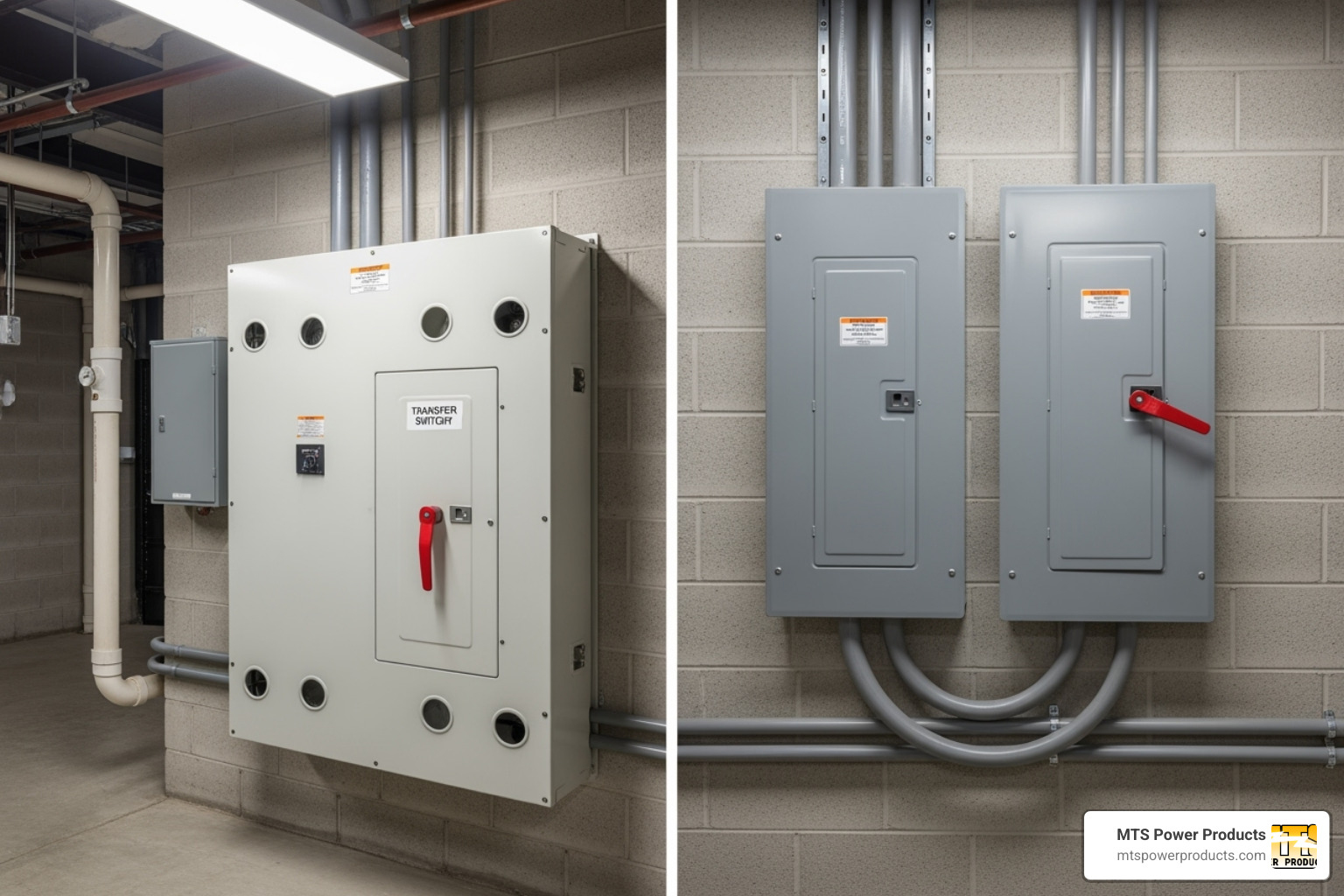
When shopping for an auto transfer switch for portable generator, you’ll encounter two main types, each designed for different backup power goals.
Load center transfer switches are the popular choice for most homeowners using portable generators. These essential circuit switches are designed to keep your most important systems running during an outage. They typically handle 8 to 16 circuits, which means you get to choose which appliances and outlets stay powered.
This type works perfectly when you want to keep your refrigerator humming, a few lights on, your furnace blower running, and maybe power a couple of outlets for charging phones. It’s like having a safety net that catches the essentials while letting the non-critical stuff (like that second TV or the garage door opener) take a temporary break.
Service disconnect transfer switches are the heavy-duty option, designed for whole-house backup power. These switches install between your electric meter and main breaker panel, essentially taking over your entire electrical system during an outage.
Here’s the reality check though – most portable generators don’t have enough muscle to power your entire house. Unless you’ve got a beast of a portable generator (think 10,000 watts or more), a service disconnect switch might be overkill. It’s like buying a massive dining table when you usually eat alone – technically possible, but probably not the smartest match.
The sweet spot for most folks is the load center approach, where you get automatic convenience for the things that really matter. For a deeper dive into how these different setups work with various generators, check out our comprehensive guide on Generator Transfer Switch options.
Getting the size right is crucial – it’s the difference between a system that works smoothly and one that leaves you frustrated in the dark. Think of it like matching your shoes to your feet; too small and you’re uncomfortable, too big and you’re tripping over yourself.
If you’re going the whole-house route with a service disconnect ATS, the math is straightforward: match the amperage to your main breaker. Got a 200-amp main breaker? You need a 200-amp transfer switch. A 100-amp service requires a 100-amp switch. This ensures your ATS can safely handle whatever your home might demand.
For load center switches, you’ll need to play detective and figure out what you actually need during an outage. Start by walking through your house and identifying your “can’t live without” items. Your refrigerator definitely makes the list (nobody wants spoiled food). Your furnace blower is probably essential for comfort. A few lights and outlets for basics round out most people’s must-have list.
Next comes the number crunching. Check the wattage on each essential appliance – it’s usually on a label somewhere. If you only see volts and amps, just multiply them together (a 10-amp appliance on 120 volts needs 1,200 watts).
Here’s where it gets tricky: starting watts vs. running watts. That refrigerator might only use 150 watts while running, but it needs a surge of 600 watts when the compressor kicks on. Your generator needs to handle these surges, or you’ll be dealing with tripped breakers and frustrated sighs.
The golden rule? Your portable generator’s capacity should exceed your total running watts, plus the largest starting surge you might encounter. Overload prevention isn’t just a nice feature – it’s essential for keeping your generator happy and your lights on.
For specialized applications requiring robust solutions, you might want to explore options like our Cummins RA Series ATS.
Not all automatic transfer switches are created equal. The right features can mean the difference between a system that just works and one that works brilliantly, keeping you comfortable and safe during outages.
Power management modules are like having a smart assistant for your electrical system. These intelligent features prevent your generator from biting off more than it can chew. The star player here is load shedding, particularly for high-demand appliances like air conditioners.
Picture this: your generator is running smoothly, powering your essentials, when suddenly your AC kicks on and demands a huge surge of power. Without load management, your generator might overload and shut down, leaving you in the dark. With smart load shedding, the system temporarily turns off non-essential loads (or even the AC itself) to prevent overload, then brings them back online when capacity allows.
NEMA enclosure ratings might sound technical, but they’re simply about protecting your investment from the weather. NEMA 1 enclosures work fine indoors, keeping dust and light splashes at bay. But if your ATS lives outside, you absolutely need NEMA 3R protection to handle rain, snow, and ice. Think of it as the difference between a light jacket and a proper raincoat.
UL 1008 certification is your quality assurance badge. This certification from Underwriters Laboratories specifically covers transfer switch equipment, ensuring your ATS meets rigorous safety and performance standards. It’s like a seal of approval that says “this device won’t let you down when you need it most.”
At MTS Power Products, we take pride in our McPherson Controls line, which integrates programmable displays and advanced switch mechanisms. These features provide improved control, diagnostics, and safety, giving you precise management over your backup power system. It’s the kind of professional-grade quality that makes the difference between hoping your power works and knowing it will.
To explore the sophisticated technology that makes these systems tick, visit our detailed page on ATS Controller features. Understanding these components helps you appreciate the intelligence behind a truly reliable backup power solution.
Implementing an auto transfer switch for portable generator is a significant upgrade to your home’s preparedness, but it’s a project that demands careful attention to installation, safety, and budget. While the convenience it offers is immense, understanding these practical aspects is key to a successful and secure setup.
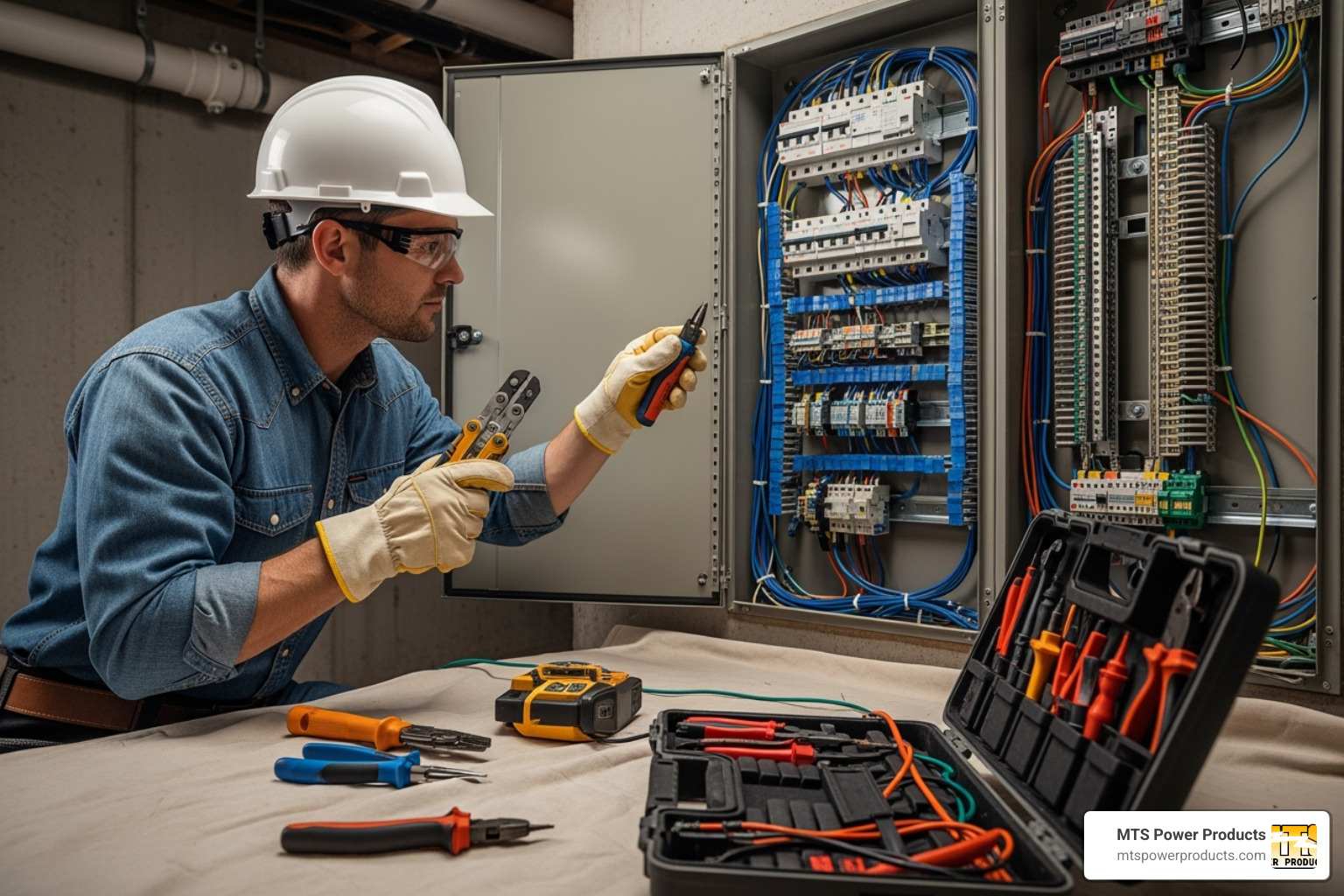
Let’s be honest – installing an ATS isn’t like changing a light bulb. This is serious electrical work that involves your home’s main power panel, and it’s absolutely not the time to channel your inner DIY hero.
Hiring a licensed electrician is non-negotiable, and frankly, it’s the smartest money you’ll spend on this project. These professionals don’t just know which wire goes where – they understand the intricate dance of electricity flowing through your home and how to keep everyone safe while they work their magic.
Your electrician will steer the maze of National Electrical Code (NEC) requirements and local building codes that govern electrical installations. They’ll also handle the permit process, which might seem like bureaucratic red tape but actually ensures your installation meets safety standards and passes inspection. Trust me, you don’t want to find code violations when you’re trying to sell your house years from now.
One critical decision you’ll make together is generator inlet box placement. This outdoor connection point needs to be strategically located – close enough to your main panel to keep wiring costs reasonable, but far enough from windows, doors, and vents to prevent dangerous carbon monoxide from sneaking into your home. Your electrician will find that sweet spot while ensuring easy access for connecting your generator.
Weatherproofing connections is where attention to detail pays off. Since your generator lives outdoors, every external component needs to withstand Mother Nature’s mood swings. That means NEMA 3R rated enclosures for outdoor installations – think of them as weatherproof armor for your electrical components.
For a comprehensive look at everything that goes into creating a complete backup power system, check out our guide on what’s in a Generator Transfer Switch Kit.
While an auto transfer switch for portable generator dramatically improves safety compared to the old extension-cord shuffle, portable generators still demand respect and careful handling.
Carbon monoxide safety is the big one – this invisible, odorless killer is responsible for hundreds of deaths each year from improperly used generators. Your generator needs to live outdoors, at least 15-20 feet from your home, with its exhaust pointed away from any opening. Even then, install battery-operated CO detectors inside your home, especially near bedrooms. Check those batteries religiously – your life literally depends on it.
Weather protection creates an interesting challenge. Your generator needs fresh air to breathe and exhaust to escape, but it also needs protection from rain and snow. Generator covers or specialized shelters solve this puzzle, keeping your unit dry while maintaining proper ventilation.
Here’s where portable generators show their limitations: fuel storage and refueling. Unlike a permanent standby generator connected to your home’s natural gas line, portable units need you to play gas station attendant. During extended outages, this means venturing out in potentially nasty weather to refuel or swap propane tanks. Gasoline requires careful storage in approved containers, while propane offers the advantage of longer shelf life and easier remote starting.
Generator starting reliability can make or break your automatic system. Your ATS can send the “start” signal all day long, but if your generator won’t fire up, you’re back to square one. Regular maintenance and periodic exercise runs keep your generator ready for action. For truly critical loads like computer equipment, consider adding a UPS (Uninterruptible Power Supply) to bridge the brief gap during power transfer.
| Pros of ATS with Portable Generator | Cons of ATS with Portable Generator |
|---|---|
| Automation: Automatic power transfer during outages, even when you’re away or asleep. No manual intervention needed. | Limited Automation: Requires remote-start capable generator. Still needs manual refueling during extended outages. |
| Safety: Prevents dangerous backfeeding to utility grid. Protects appliances from surges. Eliminates hazardous extension cords. | Safety Concerns: Generator must stay outdoors to prevent CO poisoning. Needs weather protection and CO detectors. |
| Convenience: Seamless power restoration for essential circuits. No fumbling with cords in bad weather. | Maintenance: Manual refueling can be frequent. Generator noise and fumes still present outdoors. |
| Cost: Lower initial investment than whole-house standby systems. | Ongoing Costs: Installation requires licensed electrician and permits. Fuel and maintenance costs continue. |
| Reliability: More hands-off than manual methods. Powers essential circuits automatically. | Reliability Limits: Consumer generators may have starting issues if not maintained. May need UPS for critical electronics. |
Let’s talk numbers – because while peace of mind is priceless, auto transfer switch for portable generator installations definitely have a price tag.
The ATS unit itself varies widely based on what you need. A basic 50-amp load center switch might run you $400 to $800 – perfect for powering your essentials like the refrigerator, a few lights, and your furnace. Step up to higher amperage ratings or service disconnect switches with fancy power management features, and you’re looking at $800 to $1,500 or more. For specialized commercial applications, costs can climb significantly higher, though that’s less common for typical home portable generator setups.
Professional installation will likely be your biggest expense, and rightfully so. You’re paying for expertise that keeps your family safe and your installation up to code. The final bill depends on several factors: how complex your installation is, whether your electrical panel needs upgrades, how far the inlet box is from your main panel, and where you live (labor rates vary by region). Budget anywhere from several hundred dollars to well over a thousand for professional installation.
Don’t forget about permit fees – your local municipality wants their cut, typically a few hundred dollars. Your electrician can handle this paperwork maze for you, which is worth every penny in saved headaches.
Total project budget for a complete auto transfer switch for portable generator setup (not including the generator itself) typically ranges from $1,000 to $3,000 or more. Yes, it’s a significant investment, but consider what you’re getting: automatic backup power that works even when you’re asleep, traveling, or simply don’t want to venture outside during a storm.
For a detailed breakdown of what influences these costs and how to budget effectively, take a look at our comprehensive guide on How Much Does an Automatic Transfer Switch Cost?.
In today’s world of unpredictable weather and aging power grids, losing electricity isn’t just an inconvenience—it can disrupt your entire life. An auto transfer switch for portable generator transforms what used to be a stressful, dangerous scramble in the dark into a seamless, automatic response that keeps your home running smoothly.
Throughout this guide, we’ve walked through how these remarkable devices serve as the intelligent command center of your backup power system. They constantly monitor your utility power, instantly detect outages, and smoothly orchestrate the switch to generator power without you lifting a finger. No more dangerous extension cords snaking through your house, no more risking electrocution or carbon monoxide poisoning from improper connections.
The convenience and safety benefits are undeniable. While your neighbors are fumbling with flashlights and manual connections, your refrigerator keeps humming, your furnace keeps your family warm, and your essential electronics stay protected. The automatic operation means you’re covered whether you’re sound asleep at 3 AM, stuck at work during a storm, or away on vacation.
We’ve also covered the practical side—understanding which generators work with these systems, choosing between load center switches for essential circuits versus whole-house solutions, and recognizing must-have features like power management and proper NEMA ratings. The investment typically ranges from $1,000 to $3,000+ for a complete professional installation, but the peace of mind during outages makes it worthwhile for most homeowners.
Installing an auto transfer switch for portable generator isn’t just about maintaining power—it’s about protecting your family’s comfort, safety, and security when the unexpected happens. It bridges the gap between basic portable generators and expensive standby systems, giving you professional-grade reliability at a more accessible price point.
The value of a professional-grade system becomes clear the first time it seamlessly kicks in during an outage. At MTS Power Products, we understand that every home’s power needs are unique. As a manufacturer and direct source for professional-quality generators, control panels, and automatic transfer switches right here in Miami, Florida, we offer something special—our customized McPherson Controls line that integrates programmable displays and advanced switch mechanisms for superior control and safety.
For expert guidance and a customized power solution featuring high-quality McPherson Controls, trust the specialists at MTS Power Products. We’re uniquely positioned as both manufacturer and provider, offering everything from generator sets to transfer switches and electrical components. Our central location near Miami International Airport and the Port of Miami allows us to serve customers worldwide, but our Florida neighbors get the advantage of working directly with the source.
There’s no better company in South Florida to provide custom generators, transfer switches, and complete backup power solutions. We’re here to help you create a system that fits your home perfectly and keeps your family comfortable no matter what Mother Nature throws your way.
Ready to take the next step toward energy independence? Prepare with an Automatic Generator with Transfer Switch and find what true peace of mind feels like when the lights go out everywhere else—but not at your house.
